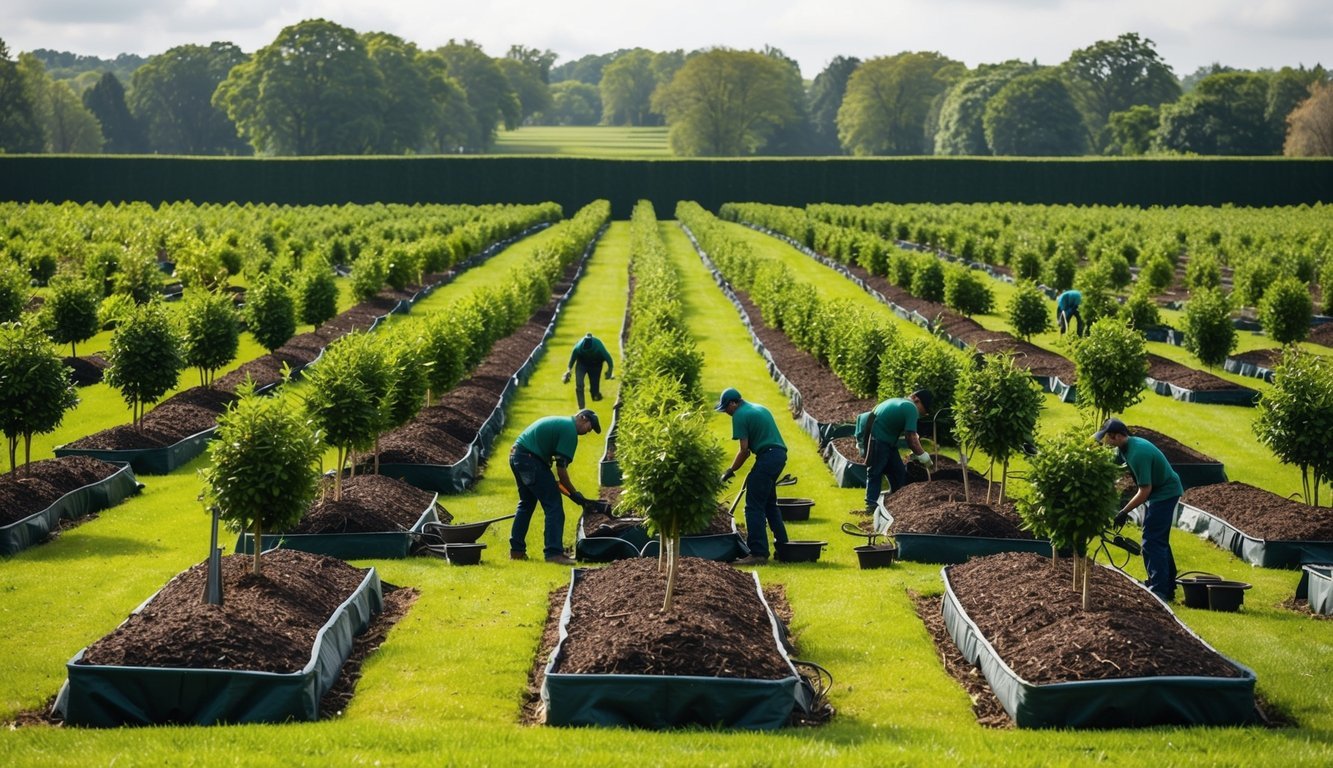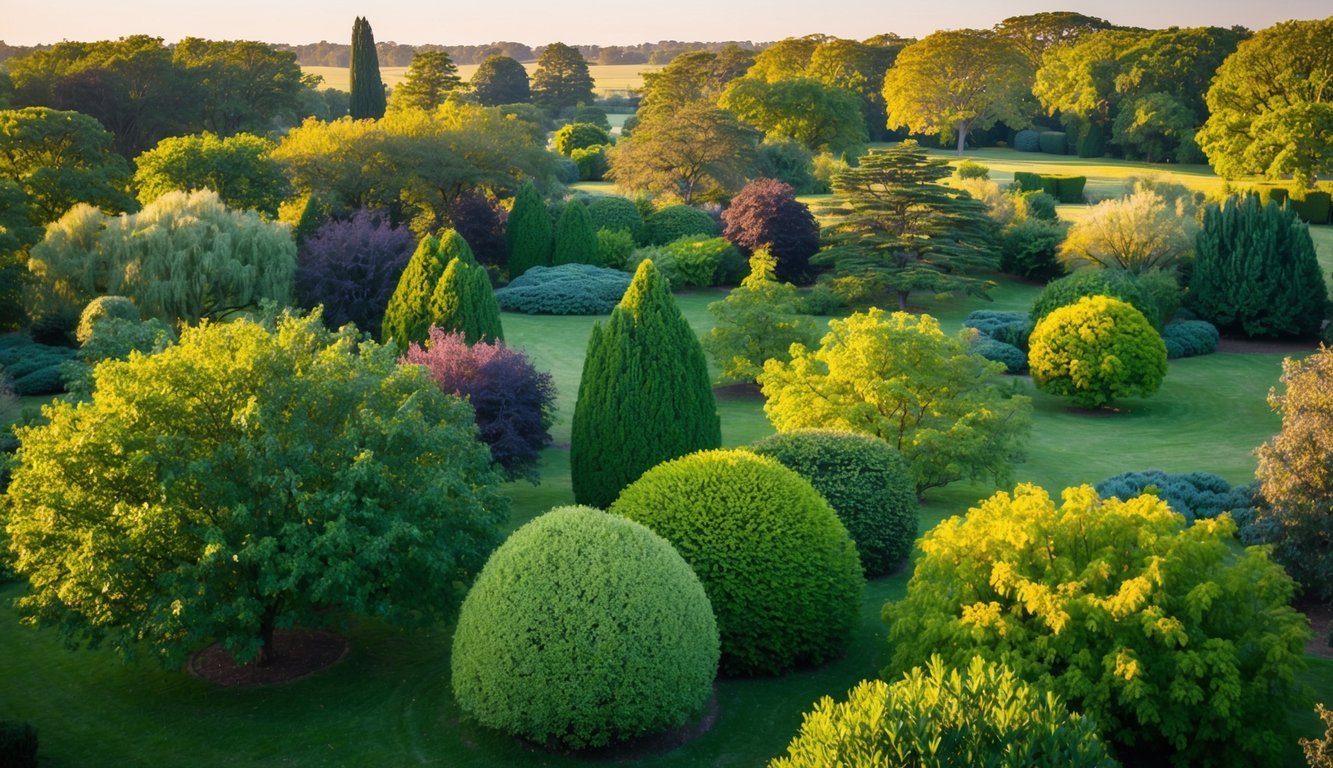Growing trees on large estates can transform your property into a stunning natural haven.
With the right approach, you can ensure that your trees not only thrive but also enhance the beauty and value of your land.

I’ve learned that successful tree growth isn’t just about planting a seed and hoping for the best.
It involves careful planning and consideration of various factors that contribute to a healthy, thriving tree ecosystem.
1) Choose native species for better growth

When I started planting trees on my estate, I quickly learned the benefits of choosing native species.
Native trees are adapted to the local climate and soil conditions, which means they’ll thrive without much fuss.
For instance, selecting trees like the American Beech can provide not only beauty but also stability.
These trees grow strong over time, offering shade and a majestic presence.
I also appreciate that native species usually require less maintenance.
They tend to have lower water and nutrient needs compared to non-natives.
This means less work for me, which is a bonus.
Additionally, native trees support local wildlife.
By planting them, I’m creating a habitat for birds, insects, and other creatures that are essential for a balanced ecosystem.
It feels good to know I’m contributing to the local environment while enhancing my landscape.
2) Regular pruning to maintain shape and health
I find that regular pruning is essential for keeping trees healthy and looking great.
By removing dead or damaged branches, I help prevent fungal infections and pest infestations that could harm my trees.
I focus on maintaining the tree’s natural shape while improving air circulation and light penetration.
This is key for promoting healthy growth and ensuring that foliage receives the sunlight it needs.
Using techniques like crown thinning can really enhance the overall health of the tree.
It allows more light to filter through, encouraging strong foliage development.
When I prune, I often use the three-cut method for larger branches to prevent bark tearing.
This technique minimizes damage and helps the tree heal better.
Regular pruning not only boosts the vitality of my trees but also enhances the aesthetic appeal of my estate, creating a well-maintained landscape that I enjoy year-round.
3) Utilize mulch to retain soil moisture
I’ve found that using mulch around my trees is essential for retaining soil moisture.
A layer about 2 to 4 inches thick works wonders.
This depth prevents evaporation while still allowing rainwater to reach the roots.
The type of mulch I choose can really affect its effectiveness.
For instance, I often use shredded leaves, which are great at holding moisture.
Straw mulch decomposes quickly and adds nutrients to the soil, benefiting the trees.
When applying mulch, I make sure the soil is clean first.
This helps prevent weeds from popping up, which can compete with my trees for water.
It’s important to spread the mulch evenly around the root zone.
Another tip I’ve learned is to avoid piling mulch against the base of the trees.
This can lead to waterlogged soil and root rot.
Keeping it a few inches away helps maintain healthy roots while still providing the moisture retention benefits I need.
4) Implement a drip irrigation system
I’ve found that a drip irrigation system is a game changer for watering trees on large estates.
It delivers water directly to the roots, where it’s needed most.
This method is efficient and conserves water, which I appreciate.
Setting up a drip system is simpler than it may seem.
I start by laying out the mainline tubing to connect to the trees.
Then, I punch holes in the tubing for smaller connectors that lead to each tree’s watering ring.
I check the system regularly, about once a month, to make sure nothing is clogged.
If I notice any issues, flushing out the lines keeps everything flowing smoothly.
It’s especially important if my water is hard, as buildup can happen faster.
This system also helps me deliver precise amounts of water based on each tree’s needs.
By monitoring how much water is used, I can adjust as necessary, ensuring my trees thrive without over or under-watering.
Implementing a drip irrigation system has made tree care on my estate much more manageable.
5) Monitor for pests like aphids or beetles

As I grow trees on my estate, I’ve learned that keeping an eye out for pests like aphids and beetles is crucial.
These little insects can quickly damage healthy trees if not caught early.
I make it a habit to check the leaves and branches regularly.
Aphids often cluster on the undersides of leaves, so that’s a prime spot to inspect.
If I see any, I look for natural predators such as ladybugs or lacewings that might be helping to control the population.
Another method I use is sticky traps placed around the trees.
They help catch flying pests and give me a visual indication of what’s visiting my trees.
For aphids, a strong spray of water can dislodge them without using chemicals.
I also consider using horticultural oils or insecticidal soap if the infestation seems serious.
Understanding Tree Growth
It’s crucial to get a grip on how trees grow if you want them to thrive on your estate.
I’ll break down some key areas to keep in mind: tree physiology and soil composition are foundational for healthy growth.
Basic Tree Physiology
Trees are fascinating organisms.
They grow primarily by converting sunlight into energy through photosynthesis.
Leaves play a critical role in this process, but there’s so much more happening beneath the surface.
Roots are vital for stability and nutrient uptake.
They not only anchor the tree but also absorb water and minerals from the soil.
The trunk serves as the central support system, facilitating the transport of nutrients and water between roots and leaves through specialized cells.
Understanding these functions can help me make better choices when caring for my trees.
Ensuring that they have sufficient light, water, and nutrients is essential for maintaining their health and encouraging growth.
Soil Composition
Soil is a tree’s lifeline.
It contains the essential nutrients trees need to grow, alongside providing a medium for root expansion.
Two main components to consider are soil texture and structure.
- Texture: Refers to the size of soil particles, which can be sand, silt, or clay. A balanced mix, often termed loam, is ideal for most trees.
- Structure: This determines how well water drains and how air circulates in the soil, both crucial for root health.
Proper soil pH is also important.
Most trees prefer slightly acidic to neutral pH levels (about 6 to 7).
Testing the soil can help me determine if I need to add amendments to enhance its fertility.
Site Preparation and Selection

Getting the site right for planting trees is vital.
The health and longevity of the trees depend on their environment and the species chosen.
Let’s dive deeper into the crucial factors that can lead to success.
Assessing Climate Conditions
Before planting, I always take time to assess the climate of my estate.
Factors like temperature, rainfall, and sun exposure play a significant role.
For instance, I note local temperature extremes in summer and winter and how much rain falls throughout the year.
I look at microclimates too.
Areas near structures or bodies of water can have slightly different conditions.
Key considerations include:
- Temperature range: Know the hardiness zones for trees.
- Rainfall patterns: Make sure trees can access enough water.
- Wind exposure: Some trees can be more resistant than others.
By understanding these conditions, I can create the best environment for my future trees.
Choosing the Right Species
Choosing the appropriate tree species is not just about aesthetics; it’s about functionality too.
I consider factors like growth rate, soil compatibility, and resistance to local pests.
Some species thrive in specific conditions.
For example:
- Native species often do well, as they’re adapted to local climates.
- Drought-resistant trees are great for less rainy areas, reducing long-term water needs.
I also think about the mature size of the trees.
Some varieties can outgrow spaces quickly, overshadowing smaller plants.
Finally, I incorporate a mix of trees for biodiversity.
This strengthens my ecosystem and can enhance property value.

